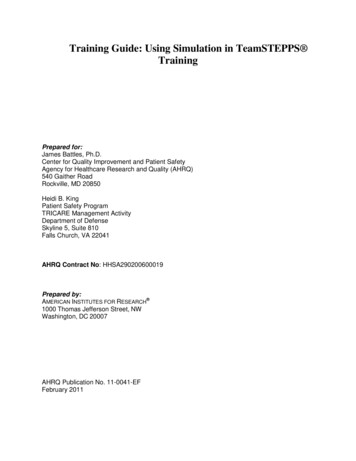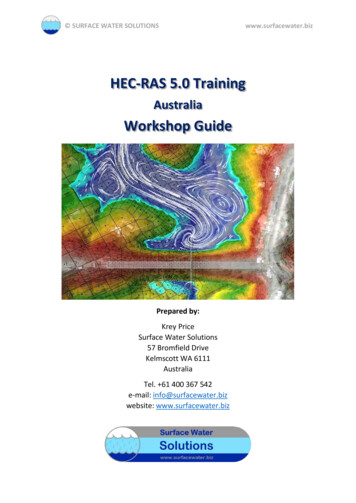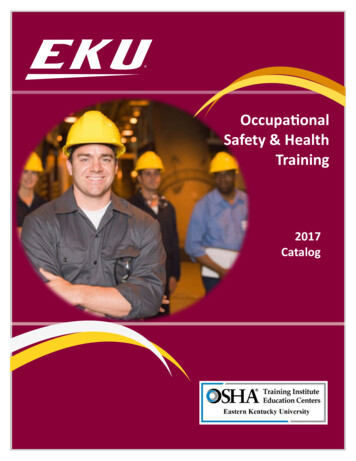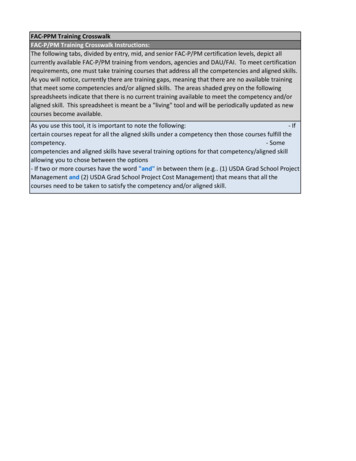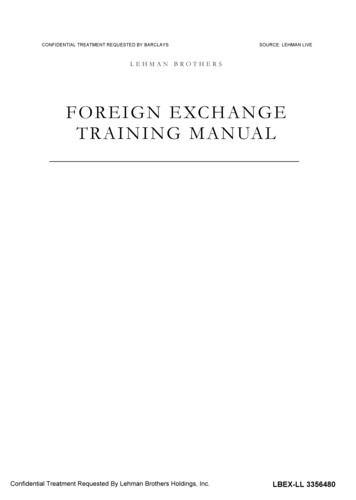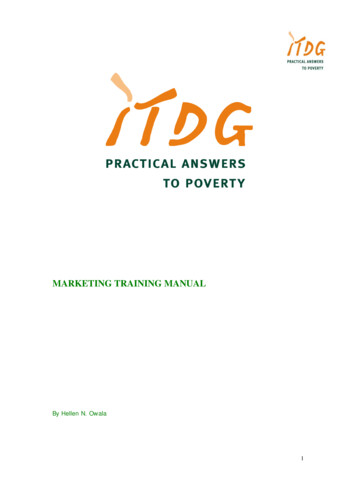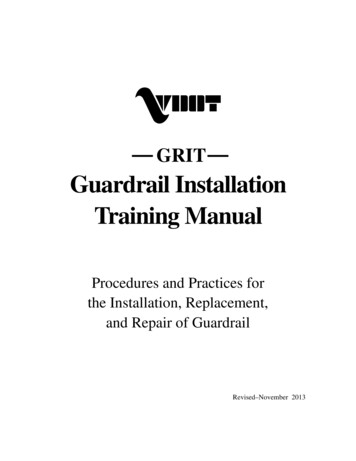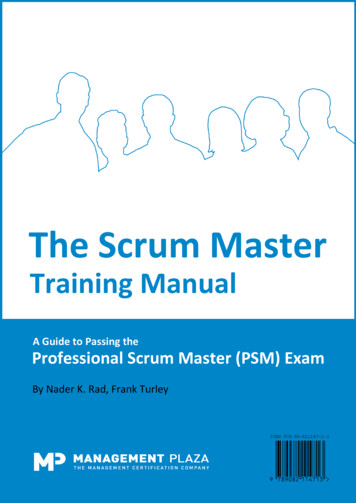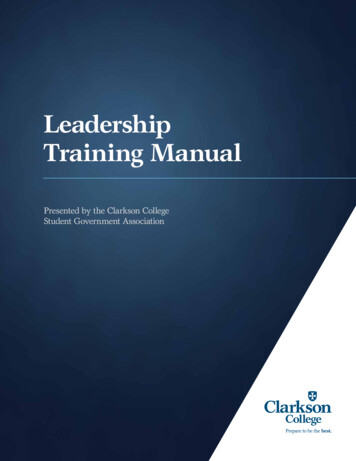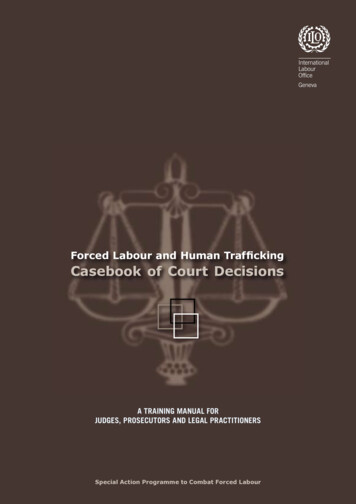
Transcription
Forced Labour and Human TraffickingCasebook of Court DecisionsA TRAINING MANUAL FORJUDGES, PROSECUTORS AND LEGAL PRACTITIONERSSpecial Action Programme to Combat Forced Labour
Forced Labour and Human TraffickingCasebook of Court Decisionsa training manual forjudges, prosecutors and legal practitioners
Copyright International Labour Organization 2009First published 2009Publications of the International Labour Office enjoy copyright under Protocol 2 of the Universal CopyrightConvention. Nevertheless, short excerpts from them may be reproduced without authorization, oncondition that the source is indicated. For rights of reproduction or translation, application should bemade to ILO Publications (Rights and Permissions), International Labour Office, CH-1211 Geneva 22,Switzerland, or by email: pubdroit@ilo.org. The International Labour Office welcomes such applications.Libraries, institutions and other users registered with reproduction rights organizations may make copiesin accordance with the licences issued to them for this purpose. Visit www.ifrro.org to find the reproductionrights organization in your country.ILO Cataloguing in Publication DataForced labour and trafficking : a casebook of court decisions : a training manual for judges, prosecutorsand legal practitioners / International Labour Office. - Geneva: ILO, 200996 p.ISBN: 978-92-2-122177-7;978-92-2-122178-4 (web pdf)International Labour Officemanual / forced labour / trafficking in persons / definition / ILO Convention / UN Convention / internationalagreement / comment / judicial decision / international court / supreme court / developed countries /developing countries13.01.2ILO Cataloguing in Publication DataThe designations employed in ILO publications, which are in conformity with United Nations practice, andthe presentation of material therein do not imply the expression of any opinion whatsoever on the partof the International Labour Office concerning the legal status of any country, area or territory or of itsauthorities, or concerning the delimitation of its frontiers.The responsibility for opinions expressed in signed articles, studies and other contributions rests solelywith their authors, and publication does not constitute an endorsement by the International Labour Officeof the opinions expressed in them.Reference to names of firms and commercial products and processes does not imply their endorsementby the International Labour Office, and any failure to mention a particular firm, commercial product orprocess is not a sign of disapproval.ILO publications and electronic products can be obtained through major booksellers or ILO local offices inmany countries, or direct from ILO Publications, International Labour Office, CH-1211 Geneva 22, Switzerland. Catalogues or lists of new publications are available free of charge from the above address, or byemail: pubvente@ilo.orgVisit our website: www.ilo.org/publnsPrinted in SwitzerlandDesigned and Photocomposed in SwitzerlandiiATABIP
PREFACEIn a global report on forced labour, published in 2005, the ILO observedthat the offence of exacting forced labour, even when recognized under nationallaw, is very rarely punished. Moreover, when forced labour cases are prosecuted, the sanctions are often very light compared to the gravity of the offence.In the years since then, there has been a slow but steady increase in nationalprosecutions, either for the offence of forced labour as such, or for relatedoffences including trafficking for either labour or sexual exploitation, debt bondage, slavery and slavery-like practices. The impetus has come in large partfrom the entry into force, in 2003, of a Protocol on human trafficking to theUnited Nations Convention against Transnational Organized Crime, adopted in2000. In the years since, a significant number of countries have amended theircriminal and other legislation in order to give specific recognition to the offenceof human trafficking for a number of purposes, including sexual exploitation,various forms of labour exploitation and the removal of organs. The penaltiesfor the criminal offence of human trafficking tend to be severe, generallyinvolving long terms of imprisonment. Law enforcement agencies are alsohaving to consider the important issue of compensation for the wrongs theyhave suffered to the victims of forced labour and trafficking.These developments are posing considerable challenges for judges and prosecutors, and for law enforcement more generally. They are required to address,often for the first time, cases of forced labour and related forms of exploitationby private agents. They are required to deal with cases in which the allegedforms of abuse may be extremely subtle, involving psychological pressures andthreats rather than overt physical restraint and violence. Moreover, they arerequired to pass judgment in different contexts, and under different legal traditions that may vary considerably in their definitions of such abuses as forcedlabour, human trafficking and exploitation. Some countries deal with forcedlabour under their criminal laws, others under their labour laws, yet othersunder both. Some countries have detailed definitions of human trafficking,perhaps including a separate chapter on forced labour; others have broaddefinitions, leaving interpretation largely to the discretion of the judiciary. Furthermore, the Palermo Trafficking Protocol introduces to international law theconcept of trafficking for exploitation. This is a notion for which there is almostno juridical precedent, and which prompts questions for both legislators andjudges. Is it linked with coercion, or can it be based instead on unacceptableworking conditions? As will be seen in this casebook, there have been differentapproaches to these questions at national level.The ILO’s first Convention on forced labour, No. 29 of 1930, contains a basicdefinition of forced labour, as a situation where work or service is exacted frompeople under the menace of any penalty, and for which they have not offeredthemselves voluntarily. The Convention also indicates that forced labour shallbe punishable as a serious offence, through penalties imposed by law that areiii
genuine disincentives and are strictly enforced. The Convention is the mostwidely ratified of all the ILO instruments, with 173 ratifications at present.The present day challenge is to apply this Convention effectively to a moderncontext in which some 80 percent of the 12 million people subjected to forcedlabour are exploited by private agents.The casebook is part of the ILO’s broader efforts to address forced labourthrough promotional means and technical cooperation. A Special Action Programme to Combat Forced Labour (SAP-FL) was created in 2001, as part ofmeasures to promote the core labour standards embodied in a 1998 Declaration on Fundamental Principles and Rights at Work. The SAP-FL programmehas conducted extensive research and surveys on modern forced labour, andstrengthened the capacity of a range of stakeholders to contribute to thefight against it. Earlier guidance manuals and toolkits have been prepared forlegislators and law enforcement, labour inspectors, employers’ organizationsand the business community, among others.We believe that the present casebook fills an important gap. It covers a rangeof national experience, from judicial decisions on forced and bonded labour ina number of developing countries, through to the more recent decisions onforced labour and trafficking in industrialized countries. In particular, it seeksto illustrate how national court decisions have taken into account the provisions of the ILO’s own Conventions on forced labour, and how this may provideuseful guidance for future court decisions. By increasing familiarization withand awareness of jurisprudence on forced labour, we hope also to promotecross-fertilization of experience and dialogue among judicial practitioners,both within domestic courts and between domestic and international courts. Toenrich future editions of this casebook, the first of its kind, we also urge readersto share copies of court decisions involving forced labour.The casebook was researched and written by Alli Jernow, ILO consultant andformer prosecutor, under the guidance of Gao Yun, Legal Officer of the SAP-FLprogramme, who designed and coordinated the project.We are grateful to the many individuals who have given their time and sharedrelevant experience. Particular thanks are due to Rosanna Carreon, whodevoted her time and energy to collecting cases through various channels andpreparing a preliminary report. Credit must be given to specialists from different ILO Departments, Regional Offices and Country Offices for their invaluablecontributions and sound comments, namely Jose Ramirez (IPEC), Rosinda Silva(NORMES), Jane Hodges (GENDER), Aurélie Hauchère, Caroline O’Reilly, BeateAndrees (SAP-FL), Tauqir Shah (Islamabad Office) and Coen Kompier (NewDelhi Office). We also want to thank Katy Thompson (UNDP), Martin Fowke(UNODC) and Richard Danziger (IOM) for taking the time to send us information and meet our researchers.iv
Special thanks go to Frédéric Kurz, the Deputy General Public Prosecutor ofthe Court of Liège, and Jonge van Ellemeet Heleen, researcher at the Bureauof the Dutch Rapporteur on Human Trafficking, who continuously send us notonly the latest court decisions from their countries but also their in-depth legalanalyses.Finally, thanks are extended to Coralie Thompson for her assistance throughthe various stages of this publication.Roger PlantHead, Special Action Programmeto Combat Forced Labourv
PREFACEiii1. INTRODUCTION11.1 The ILO and Forced Labour1.2 How the ILO Works1.3 Aims of Casebook1.4 Reading this Casebook: An Overview of Common Themes2. INTERNATIONAL INSTRUMENTS123592.1 The ILO Forced Labour Conventions and ILO Views102.1.1 Forced Labour Convention, 1930 (No. 29)102.1.2 Abolition of Forced Labour Convention, 1957 (No. 105)112.1.3 Worst Forms of Child Labour Convention, 1999 (No. 182)112.1.4 The ILO Committee of Experts on the Meaning of Forced Labour122.213The UN Slavery Conventions2.2.1 Slavery Convention, 19262.2.2 Supplementary Convention on the Abolition of Slavery, the Slave Trade,and Institutions and Practices Similar to Slavery, 19562.3International Criminal Instruments2.3.1 The Protocol to Prevent, Suppress and Punish Trafficking in Persons, EspeciallyWomen and Children, supplementing the United Nations Convention againstTransnational Organized Crime, 2000131315152.3.2 The Statute of the International Criminal Tribunal for the Former Yugoslavia, 1993172.3.3 Rome Statute of the International Criminal Court, 1998173. FORCED LABOUR IN INTERNATIONAL COURTS193.1 The International Court for the Former Yugoslavia:Defining and Refining the Concept of Enslavement193.1.1 Defining Enslavement: Prosecutor v. Kunarac, Case No. IT-96-23(22 February 2001) and Case No. IT-96-23-A (12 June 2002) (Appeals Chamber)193.1.2 Climate of Fear: Prosecutor v. Krnojelac, Case No. IT-97-25 (15 March 2002)and Case No. IT-97-25-A (17 September 2003) (Appeals Chamber)213.1.3 A Closer Look at the Concept of Climate of Fear4. FORCED LABOUR IN REGIONAL COURTS26274.1 The European Court of Human Rights:Imposing Positive Obligations on States for Individual Violationsof Criminal Law274.1.1 Offer to Work Not Involuntary: Van der Mussele v. Belgium,Application No. 8919/90 (23 November 1983)274.1.2 Extreme Vulnerability Amounting to Menace of a Penalty: Siliadin v. France,Application No. 73316/01 (26 July 2005)304.2 Economic Community of West African States (ECOWAS) CommunityCourt of Justice: Recognizing Positive Obligations of States toProtect Individuals from Slavery364.2.1 Holding States Accountable: Hadijatou Mani v. Republic of Niger, CommunityCourt of Justice (27 October 2008)365. FORCED LABOUR IN SOUTH ASIA5.1 India41425.1.1 Payment Below the Minimum Wage: People’s Union for Democratic Rightsv. Union of India, A.I.R. 1982 S.C. 1473 (19 September 1982)425.1.2 Creating a Rebuttable Presumption of Forced Labour: Bandhua Mukti Morchav. Union of India, A.I.R. 1984, S.C. 820465.1.3 Another Look at Peonage and Bonded Labour505.252Pakistan5.2.1 Court Decision Leading to Enactment of Legislation: Darshan Masih v. State,P.L.D. 1990 S.C. 513525.2.2 Requiring Physical Restraint for Forced Labour: Judgment of High Court of Sindh,Circuit Court, Hyderabad (2002)54
6. FORCED LABOUR IN EUROPE6.1 Belgium57576.1.1 Finding Working Conditions Contrary to Human Dignity: Public Ministryv. Wang Li Kang, Wang Qi et al., Court of Appeal of Liège, Decision No. 2007/245(24 January 2007)586.1.2 Abuse of a Condition of Vulnerability as Aggravated Circumstance: Public Ministryv. Cengiz Yönel and Abdellah Bouassam, Penal Court of Verviers,Decision No. 69.98.954/06 (15 January 2007)596.2 France6.2.1 Risk of Unemployment as Abuse of Economic Dependence: Procureur de laRépublique v. Monsieur B., Decision No. 97/8641, Court of Appeal of Poitiers(26 February 2001)6.3 Netherlands6.3.1 Abuse of Vulnerability but Not Exploitation: The Public Prosecution Servicev. The Accused, No. 07.976405-06, District Court of Zwolle (29 April 2008)7. FORCED LABOUR IN THE AMERICAS7.1Brazil7.1.1 Using a Company Store to Create ‘Chains’: Public Ministry of Labourv. Lazaro Jose Veloso (Fazenda Sao Luiz), Judgment No. 218/2002, 30 April 20037.1.2 First Prison Sentence for Forced Labour: Federal Public Ministryv. Gilberto Andrade, Judgment N 2000.37.00.002913-2, Penal Court ofMaranhão State, 23 April 20087.2The United States6162646569697172777.2.1 Forced Labour as a Norm of International Customary Law: Individual Liability forViolations of International Law777.2.2 Forced Labour as a Violation of Customary International Law: Iwanowav. Ford Motor Co., 67 F. Supp 2d 424 (D.N.J. 1999)787.2.3 Debts Not Owed to Employer mean no Forced Labour: Doe I v. The Gap,2001 WL 1842389 (D.N. Mar. I. 2001)807.2.4 Inters
A TRAINING MANUAL FOR JUDGES, PROSECUTORS AND LEGAL PRACTITIONERS Special Action Programme to Combat Forced Labour International Labour Offi ce Programme on the Promotion of the Declaration on Fundamental Principles and Rights at Work 4, route des Morillons CH-1211 Geneva 22 Switzerland. a training manual for judges, prosecutors and legal practitioners Forced Labour and


